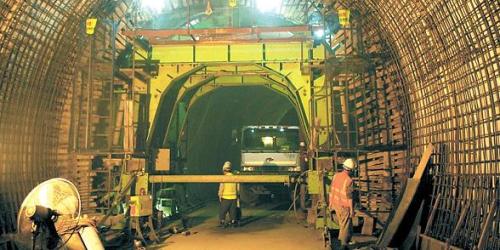Safe handling of radioactive waste, which is hazardous to most forms of life and the environment, is essential for countries that depend heavily on nuclear energy.
Following a recommendation by the International Atomic Energy Agency, the Korea Radioactive Waste Management Corp. was launched in 2009 to transport, store, treat and dispose of radioactive waste, build and manage radioactive waste disposal facilities, and conduct related research and development.
The KRMC is scheduled to complete the construction of an underground facility to dispose of low and intermediate-level radioactive waste by the end of June 2014 in Gyeongju, North Gyeongsang Province.
Gloves and equipment components from nuclear power plants with low levels of contamination and short half-lives fall under the category of low and intermediate-level radioactive waste. They are stored in temporary repositories within the nuclear power plant sites until the Gyeongju facility is completed.
 |
Construction to build a radioactive waste disposal facility is under way in Gyeongju, North Gyeongsang Province. (KRWMC) |
The KRMC also plans to draw up measures to handle spent fuel rods as they are expected to run out of storage space in 2016. Spent fuel rods, which have been irradiated in nuclear reactors and contain fission products considered radioactive waste, are currently kept in water tanks at nuclear power plants. About 96 percent of them can be recycled.
The construction of the radioactive waste disposal facility in Gyeongju began in 2008 after it was approved by a majority of residents in a referendum in 2005.
It will have the capacity to store 800,000 200-liter drums of waste.
Disposal silos are currently being built at 80-130 meters below the ground where clothing and gloves from nuclear power plants, hospitals and research institutes will be put.
Radioactive waste transported to the site by trucks and vessels specially designed according to IAEA rules will be inspected at a ground-level facility before being stored indefinitely in the underground repositories.
The disposal facility is being built so that it can withstand earthquakes with a magnitude of 6.5, just like the nuclear power plants.
It will be operated for 60 years and will be shut down when the repositories are full. The site will be kept off-limits and subject to environmental inspections and limited use of land for safety reasons for up to 300 years by when the radioactive waste will have decayed.
The KRMC has emergency guidelines in case of radioactive material leaks to protect the workers and residents in neighboring areas, and conducts regular training programs for prevention of radioactive leaks.
The level of radioactivity around the disposal facility is kept under 0.01 mSv annually, which is about a hundredth of the radioactivity permitted for human exposure per year or about a fifth of the radioactivity from a chest X-ray test.
Environmental radiation is monitored within a 35-kilometer radius of the disposal facility by both governmental and nongovernmental watchdogs, and the results are made public.
They measure and analyze environmental radiation levels in water, soil, terrestrial and marine life on a regular basis, write reports on them for disclosure on the KRMC website.
The construction period of the Gyeongju facility was recently extended by 18 months as the underground bedrock around the silo required more reinforcement work.
The structural safety of the repository has been confirmed by an Austrian design company named 3G, the Korea Tunneling and Underground Space Association and the Korea Institute of Nuclear Safety.
By Kim So-hyun (
sophie@heraldcorp.com)








